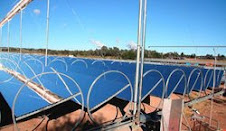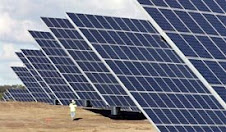FIRST: UCLA
UCLA engineers pioneer affordable alternative energy-solar energy cells made of everyday plastic
Researchers at the UCLA Henry Samueli School of Engineering and Applied Science hope to meet the growing demand with a new and more affordable way to harness the sun's rays: using solar cell panels made out of everyday plastics.
With oil and gas prices in the United States hovering at an all-time high, interest in renewable energy alternatives is again heating up. Researchers at the UCLA Henry Samueli School of Engineering and Applied Science hope to meet the growing demand with a new and more affordable way to harness the sun's rays: using solar cell panels made out of everyday plastics.
In research published today in Nature Materials magazine, UCLA engineering professor Yang Yang, postdoctoral researcher Gang Li and graduate student Vishal Shrotriya showcase their work on an innovative new plastic (or polymer) solar cell they hope eventually can be produced at a mere 10 percent to 20 percent of the current cost of traditional cells, making the technology more widely available.
"Solar energy is a clean alternative energy source. It's clear, given the current energy crisis, that we need to embrace new sources of renewable energy that are good for our planet. I believe very strongly in using technology to provide affordable options that all consumers can put into practice," Yang said.
The price for quality traditional solar modules typically is around three to four times more expensive than fossil fuel. While prices have dropped since the early 1980s, the solar module itself still represents nearly half of the total installed cost of a traditional solar energy system.
Currently, nearly 90 percent of solar cells in the world are made from a refined, highly purified form of silicon -- the same material used in manufacturing integrated circuits and computer chips. High demand from the computer industry has sharply reduced the availability of quality silicon, resulting in prohibitively high costs that rule out solar energy as an option for the average consumer.
Made of a single layer of plastic sandwiched between two conductive electrodes, UCLA's solar cell is easy to mass-produce and costs much less to make -- roughly one-third of the cost of traditional silicon solar technology. The polymers used in its construction are commercially available in such large quantities that Yang hopes cost-conscious consumers worldwide will quickly adopt the technology.
Independent tests on the UCLA solar cell already have received high marks. The nation's only authoritative certification organization for solar technology, the National Renewable Energy Laboratory (NREL), located in Golden, Colo., has helped the UCLA team ensure the accuracy of their efficiency numbers. The efficiency of the cell is the percentage of energy the solar cell gathers from the total amount of energy, or sunshine, that actually hits it.
According to Yang, the 4.4 percent efficiency achieved by UCLA is the highest number yet published for plastic solar cells.
Read more at PhysOrg.com
SECOND, Wake Forest: NMSU/Wake Forest solar breakthrough will help spur viability of alternative energy
The silicon level of energy conversion has been a difficult reach for researchers on organic solar technology, with many of them hitting about 3 to 4 percent. But the NMSU/Wake Forest team has achieved a solar energy efficiency level of 5.2 percent.
SANTA FE -- Imagine being able to “paint” your roof with enough alternative energy to heat and cool your home. What if soldiers in the field could carry an energy source in a roll of plastic wrap in their backpacks?
Those ideas sound like science fiction ? particularly in the wake of the rising costs of fossil fuel.
But both are on the way to becoming reality because of a breakthrough in solar research by a team of scientists from New Mexico State University and Wake Forest University.
While traditional solar panels are made of silicon, which is expensive, brittle and shatters like glass, organic solar cells being developed by this team are made of plastic that is relatively inexpensive, flexible, can be wrapped around structures or even applied like paint, said physicist Seamus Curran, head of the nanotechnology laboratory at NMSU. Nanotechnology, or molecular manufacturing, refers to the ability to build things one atom at a time.
The relatively low energy efficiency levels produced by organic solar cells have been a drawback. To be effective producers of energy, they must be able to convert 10 percent of the energy in sunlight to electricity. Typical silicon panels are about 12 percent energy conversion efficient.
That level of energy conversion has been a difficult reach for researchers on organic solar technology, with many of them hitting about 3 to 4 percent. But the NMSU/Wake Forest team has achieved a solar energy efficiency level of 5.2 percent. The announcement was made at the Santa Fe Workshop on Nanoengineered Materials and Macro-Molecular Technologies, which opened Sunday and continues through Friday.
“This means we are closer to making organic solar cells that are available on the market,” Curran said.
Conventional thinking has been that that landmark was at least a decade away. With this group’s research, it may be only four or five years before plastic solar cells are a reality for consumers, Curran added.
The importance of the breakthrough cannot be underestimated, Curran said.
“We need to look into alternative energy sources if the United States is to reduce its dependence on foreign sources,” the NMSU physics professor said.
New Mexico Economic Development Department Secretary Rick Homans added, “This breakthrough pushes the state of New Mexico further ahead in the development of usable solar energy, a vital national resource. It combines two of the important clusters on which the state is focused: renewable energy and micro nano systems, and underlines the strong research base of our state universities.”
A cheap, flexible plastic made of a polymer blend would revolutionize the solar market, Curran said.
“Our expectation is to get beyond 10 percent in the next five years,” Curran said. “Our current mix is using polymer and carbon buckyballs (fullerenes) and good engineering from Wake Forest and unique NSOM imaging from NMSU to get to that point.”
Read more about Organic Solar Cells at NMSU.edu
alternative energy
renewable energy
solar power
books
ecology
environment
clean energy
climate change
photovoltaics
technology
Best Green Stocks Investing Blog
Subscribe to:
Post Comments (Atom)
Yuya Joe Blog
Lake Ontario Waterkeeper
The Daily Beast -Politics Blog
21stArch.com - 21st Century Architecture
Original Joe College Blog
WikiLeaks Foreign Policy Analysis
AGreenRealtor.com Real Estate Blog - Ecology Energy Efficiency
Best Green Stocks Investing Blog
PV Intell Photovoltaic Solar Stocks Investing
SEARCH Leading Alternative Energy and Ethical Investing websites

Custom Search
Daily Kos
Rare Earth Stocks Research
Patrick MacManus's Blog Peace and Collaborative Development
BeesTreesFrogsElephants.com - Nature and Ecology Blog
Research Green Energy stocks, Clean Energy investing information
Find wind power investing info online, clean energy mutual funds, geothermal stocks, solar energy investments.

Green Energy Investing Network:
Green Stocks Investing Clean Power Blog
SolarIntell.com Renewable Power Investing Website
Wind Intell.com Wind Energy Stocks Company Links
Geothermal Power Investing Public Companies
PV Intell.com Leading Photovoltaic Solar Energy Stocks

Custom Search
Green Energy Investing Network:
Green Stocks Investing Clean Power Blog
SolarIntell.com Renewable Power Investing Website
Wind Intell.com Wind Energy Stocks Company Links
Geothermal Power Investing Public Companies
PV Intell.com Leading Photovoltaic Solar Energy Stocks







1 comment:
Simple trick to cut your power bill by 75%:
Want to know how to easily produce all of the renewable energy you could ever want right at home?
And you will be able to make your home completely immune from power outages, blackouts, and energy grid outages…
so even if everyone else in your area (or even the whole country) loses power you won’t.
HERE'S HOW: DIY HOME ENERGY
Post a Comment